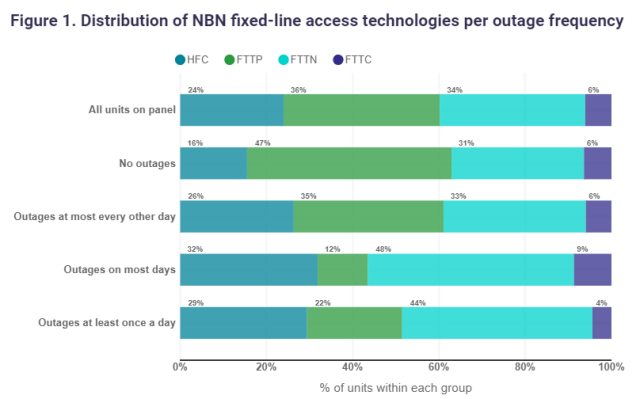Australians with Fibre to the Premises (FTTP) broadband connections experience fewer outages than any other National Broadband Network (NBN) connection type, according to the Australian Competition and Consumer Commission’s (ACCC) latest Measuring Broadband Australia report.

The report compared the performance of NBN fixed-line technologies in terms of outage frequency, latency, and packet loss. It found that users with Fibre to the Node (FTTN) and Hybrid Fibre Coaxial (HFC) connections face more frequent outages compared to FTTP users.
During the testing period, FTTN connections accounted for 48 percent of services that experienced outages on most days, despite making up only 34 percent of all NBN fixed-line connections in the Measuring Broadband Australia program. Conversely, FTTP connections, representing 36 percent of the program’s connections, accounted for 12 percent of daily outage-prone services.
“While all NBN fixed-line connection types experience some outages, there is a noticeable increase in the frequency of these outages if you have an FTTN or HFC connection,” ACCC Commissioner Anna Brakey stated. “If a consumer is experiencing frequent outages, we encourage them to contact their broadband provider for assistance. They may be able to access an FTTP upgrade at their address or obtain a mobile backup to provide service continuity during outages.”

Broadband Quality: Latency and Packet Loss
The report also assessed broadband connection quality through latency and packet loss metrics. Latency measures the time it takes to send data from a user’s device to a server and back, while packet loss refers to the data not received when using online applications. High latency and packet loss can disrupt online experiences.
The average latency for NBN fixed-line connections was found to be 10.7 milliseconds, and the average packet loss was 0.16 percent, both of which are unlikely to disrupt common online applications. FTTP connections recorded the lowest average latency and packet loss, with minimal variation across households, indicating a more reliable experience for applications requiring low latency and packet loss.
Download Speeds: Close to Advertised Rates
Broadband retailers continued to deliver download speeds close to their maximum plan speeds during March 2024. For the first time, Telstra recorded the highest average download speed during busy hours (7-11pm) among featured retail service providers, with NBN fixed-line connections on the Telstra network achieving 102.3 percent of plan speed.
The average busy hour download speed across all retail service providers was 99.8 percent of plan speed, up from 99.3 percent last quarter. The proportion of underperforming services was 4.1 percent, the lowest in the program’s history, though FTTN connections still had higher rates of underperformance than other connection types.
Expanding Monitoring to Satellite Services
The ACCC is exploring the possibility of monitoring satellite services, including those provided by NBN SkyMuster and Starlink, as part of the Measuring Broadband Australia program. Consumers using satellite services are encouraged to volunteer through the Measuring Broadband Australia website.
The data for Measuring Broadband Australia is provided by UK-based firm SamKnows, utilizing a methodology consistent with speed testing programs in the UK, US, Canada, and New Zealand.
